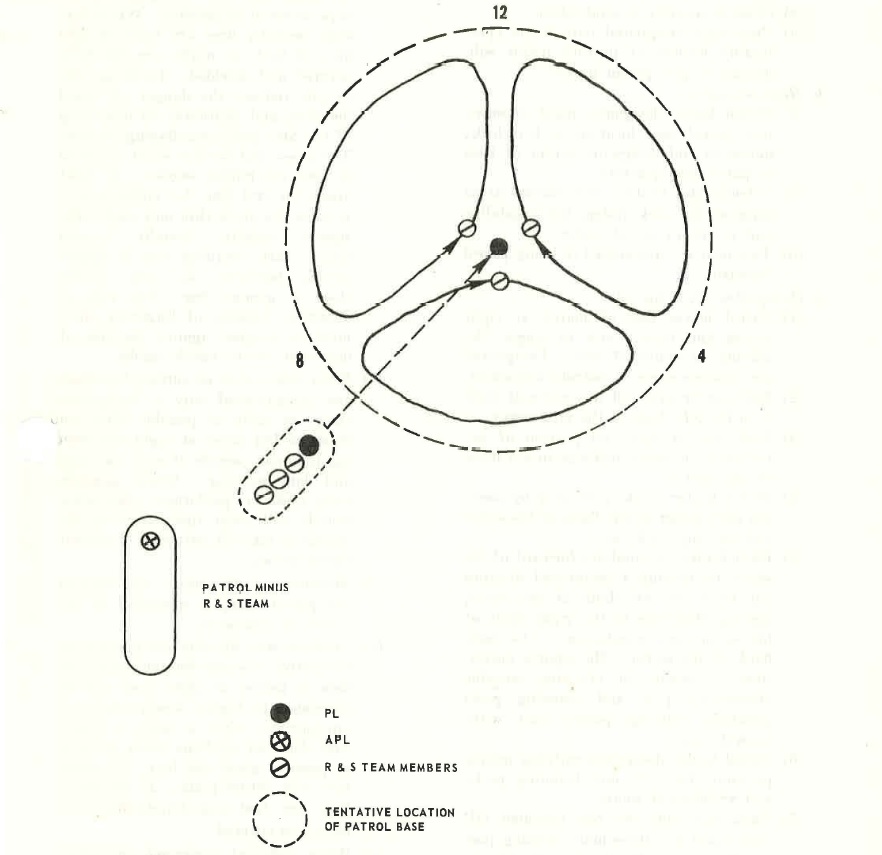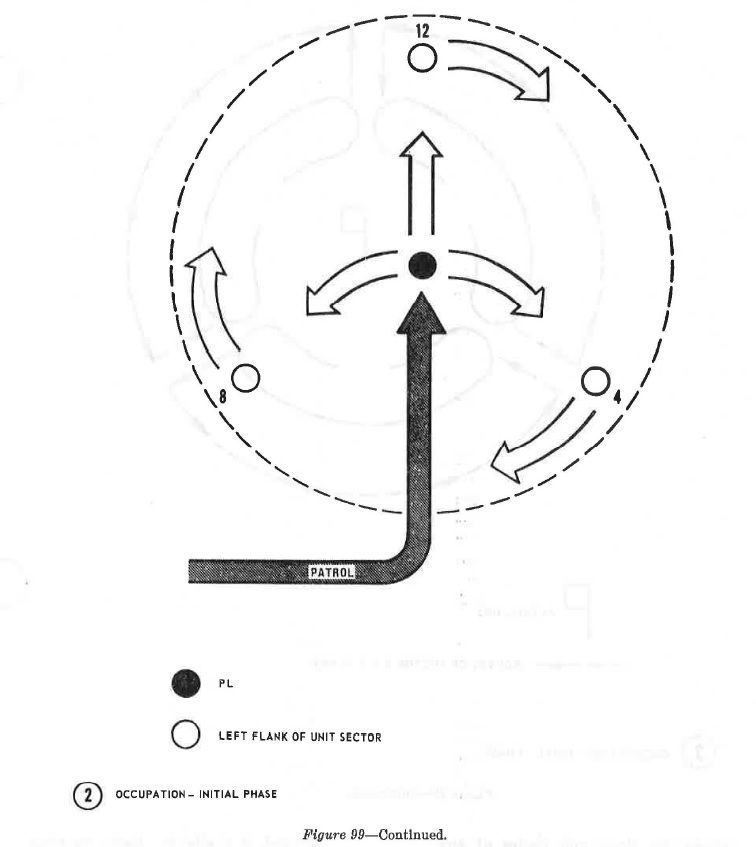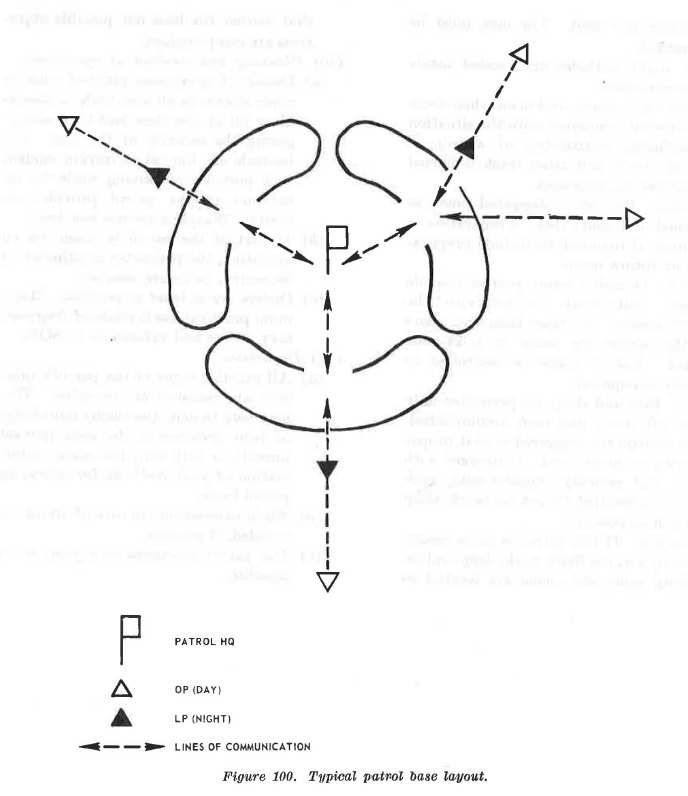Donate
| SECTION I | ---------------------------------- | GENERAL |
| SECTION I | ---------------------------------- | PATROL BASE |
214. General.
a. A patrol base is a position established when a patrol halts for an extended period. When a patrol is required to halt for an extended period in an area not protected by friendly troops, it must take active and passive measures to provide maximum security while in such a vulnerable situation. The most effective means is to select, occupy, and organize an area which, by its location and nature, provides passive security from enemy detection. An area so selected, occupied, and organized is termed a patrol base.
b. Planning for establishment of a patrol base is usually a part of the overall plan for a patrol's operation. In some circumstances, however, establishment of a patrol base may be an on-the spot decision.
c. The maximum length of time a patrol base may be occupied depends on the need for secrecy. This, in turn, may depend on whether the patrol is engaged in conventional or counter guerrilla operation. In either situation, occupation must not exceed 24 hours except in an extreme emergency such as when air evacuation is not available for wounded whose condition or number prevents the patrol from moving to a new base. In all situations, a patrol base is occupied the minimum time necessary to accomplish the purpose for which it is established. The same patrol base is not used again at a later date.
(1) In conventional operations secrecy is mandatory. The enemy must always be presumed capable of artillery, air, or ground attack if a patrol base is discovered. In this situation, a patrol base is evacuated if discovery i,S even suspected.
(2) In counter guerrilla operations, secrecy is always desirable, but may not always be as essential as in conventional operations. The need for secrecy, and evacuation if discovered, depends on the degree of control the guerrilla force has of the area, their capability to react to the discovery of a patrol base, and their capability to adversely affect the patrols operation. When the guerrilla force is relatively sma11 and weak, secrecy may not be an essential consideration, and evacuation, if discovered, may not be required. In an area controlled by a large guerrilla force with a relatively high degree of combat capability secrecy is mandatory, and evacuation, if discovered, is usually required.
215. Purposes.
a. Typical situations that require planning for the establishment of a patrol base include those where there will be:
| NUMBER | DESCRIPTION |
| 1 | A requirement to cease all movement to avoid detection. |
| 2 | A requirement to hide the patrol during a lengthy, detailed reconnaissance of the objective area. |
| 3 | A need to prepare food, maintain weapons and equipment, and rest after extended movement. |
| 4 | A need to formulate a final plan and issue necessary orders prior to actions at the objective. |
| 5 | A requirement for reorganization after a patrol hits infiltrated the enemy area in small groups (used in conjunction with a rendezvous point). |
| 6 | A need for a base from which to conduct several consecutive or concurrent operations such as ambush, t'!tid, reconnaissance, or surveillance patrols. |
b. Any unforeseen situation, similar to those above, occurring during conduct of a patrol could lead to an on-the-spot decision to establish a patrol base.
216. Selection.
a. The location for a patrol base is usually selected by map reconnaissance during patrol planning. Selection may also be by aerial reconnaissance or may be based on prior knowledge of a suitable location.
b. A patrol base established as the result of an on-the-spot decision may be the reconnaissance, securing, expansion, and organization of the area occupied during a security halt.
c. A patrol base location selected by map or aerial reconnaissance or by prior knowledge of an area is tentative. Its suitability must be confirmed and it must be secured before occupation.
d. Plans to establish a patrol base must include selection of an alternate location, a. rendezvous point, and a rallying point.
| NUMBER | DESCRIPTION |
| (1) | The alternate patrol base location is for use if the initial location proves unsuitable or if the patrol is required to prematurely evacuate the initial location. In conventional operations, it is usually desirable to reconnoiter the alternate location and keep it under surveillance until occupied or until no longer needed. The need for this reconnaissance and surveillance is not as great in counter guerrilla operations and is less likely to be possible or practical. |
| (2) | The rendezvous point is for use if the patrol evacuates the patrol base by exfiltration of groups. The rendezvous point will not have been reconnoitered (para 139). |
| (3) | The rallying point is for use if the patrol is dispersed from the patrol base. It is a point over which the patrol has previously passed, has been found suitable, and is known to all (para 127). |
217. Considerations.
Planning for a patrol base must include considerations of the mission and both passive and active security measures.
a. Mission.
A patrol base must be located so that it best enables the patrol to accomplish its mission.
b. Passive Security Measures.
(1) Select-
(a) Terrain which would be considered of little tactical value.
(b) Difficult terrain which would impede foot movement.
(c) An area of dense vegetation, preferably bushes and trees that spread out close to the ground.
(d) An area remote from human habitation.
(e) An area near a source of water.
(2) Avoid:
(a) Known or suspected enemy positions.
(b) Built-up areas.
(c) Ridge lines and topographic crests, except as necessary for maintaining adequate communications.
(d) Roads, trails, and natural lines of drift.
(e) Wet areas, steep slopes, and small valleys which may be lines of drift.
c. Active Security Measures. Plan for:
(1) Outpost and listening post systems covering avenues of approach into the area.
(2) Communications with outposts and listening posts to provide early warning of enemy approach.
(3) Defense of the patrol base, if required.
(4) Withdrawal, if required, to include multiple withdrawal routes.
(5) An alert plan to insure the necessary personnel are awake at all times.
(6) Enforcement of camouflage, noise, and light discipline.
(7) The conduct of necessary activities with minimum movement and noise.
SECTION II. PATROL BASE.
218. Occupation and Operation of a Patrol Base.
A patrol base may be occupied in either of two ways: by moving to the selected site and expanding into and organizing the area in the same manner as an on-the-spot establishment, or, by halting near the selected site and sending forward reconnaissance forces. The method used must be thoroughly planned and rehearsed. The establishment and use of patrol base drills in these methods will assist in the swift and efficient establishment of patrol bases. Occupation, using an example patrol base drill, and subsequent operation is described below (1, fig. 99).

Figure 99. Patrol base establishment.
a. Approach.
(1) Patrol is halted at last suitable position within about 200 meters of the tentative patrol base location.
(2) Close-in security is established.
(3) Previously designated individuals (preferably leaders of patrol's major subdivisions) join patrol leader.
b. Reconnaissance.
(1) Patrol leader designates point of entry into patrol base location as 6 o'clock; moves to and designates center of base as patrol headquarters.
(2) Subordinate leaders reconnoiter areas assigned by clock system for suitability and return to patrol leader.
(3) Two men are dispatched to bring patrol forward.
c. Occupation (2, 3, fig. 99).
| NUMBER | DESCRIPTION |
| (1) | Patrol leaves line of march at right angles and enters base in single file, moving to center of base. Designated men remove signs of patrol's movement. |
| (2) | Each leader peels off his unit and leads it to the left flank of the unit sector. |
| (3) | Each unit occupies its portion of perimeter by moving clockwise to left flank of next sector. |
| (4) | Patrol leader checks perimeter by meeting each leader at left flank of his sector and moving clockwise. |
| (5) | Each leader reconnoiters forward of his sector by moving a designated distance out from the left flank of his sector, moving clockwise to the right limit of his sector, and re-entering at the right flank of his sector. He reports indications of enemy or civilians, suitable observation post and listening posts positions, rallying points, and withdrawal routes. |
| (6) | Patrol leader designates rallying points, positions for OPs and listening ·posts, and withdrawal routes. |
| (7) | Each unit puts out one two-man OP (day) and one three-man listening post (night) and establishes communications. |
d. Operation (fig. 100).
(1) Security.
(a) Only one point of entry and exit is used. This point is camouflaged and guarded at all times.
(b} Fires are built only when necessary and, as a general rule, only in daylight. Whether day or night, only necessary fires are built and they are kept as small as possible. Where terrain permits, fires are built in pits and, if built at night, are .carefully covered and shielded.
Building fires in pits reduces the danger of visual detection and facilitates extinguishing of the fires and camouflaging of sites. The driest and hardest wood available is used (to reduce smoke) . In most areas, the best time for building fires is when the air is thin and smoke dissipates quickly (usually around noon); early morning may be appropriate, however, in areas where there is ground fog. The risk of detection, because of lingering odor, must be weighed against the risk of detection due to visible smoke.
(c) Noisy tasks, such as cutting branches, are accomplished only at designated times, as early as possible after occupation but never at night nor during the quiet periods of early morning and late evening. When possible, noisy tasks are performed when other sounds will cover them, such as the sounds of aircraft, artillery, or distant battle noises.
(d) Movement, both inside and outside the patrol base, is restricted to the necessary minimum.
(e) Civilians who discover the location of the patrol base are detained until the base is moved or until they can be evacuated to higher headquarters, as appropriate. Care is taken to insure that detained civilians learn as little as possible about the base, its operation, and future plans. If necessary, they are tied and blindfolded and their ears covered.
(f) When sufficient personnel are available, OPs are manned by at least two individuals so they can alternate and insure alertness at all times. This also removes the need for traffic between the OP and the patrol base.

Figure 99. Continued.
(g) When sufficient personnel are available, listening posts are manned by at least two, preferably three, individuals so they too can alternate and remain alert without back-and-forth movement.
(h) A 1-hour stand-to is observed morning and evening; 30 minutes before and 30 minutes after light in the morning, and 30 minutes before and 30, minutes after dark in the evening. This insures that every man is acclimated to changing light conditions, and is dressed, equipped, and ready for action.
(i) Each man makes certain that he knows the locations of men and positions to his flanks, front, and rear, and that he knows the times and routes of any expected movement within, into and out of the patrol base.

Figure 99. Continued.
(2) Defense. Defensive measures are planned but a patrol base is usually defended only when evacuation is not possible.
| NUMBER | DESCRIPTION |
| (a) | Elaborate firing positions are not constructed. |
| (b) | Camouflage and concealment are stressed. |
| (c) |
Artillery and mortar fires may be planned, if available. Early warning devices may be placed on avenues of
approach. If the base definitely will be defended, mines, trip flares, and booby traps may be placed on avenues
of approach and in areas which cannot be covered by fire.
The value of these devices must be weighed against the fact that their discovery automatically compromises the patrol base. |
| (d) | An alert plan is established. This includes plans for evacuation and defense. All members must know these plans and the signals or orders for their implementation. Plans for defending the base include pursuit and destruction of the attacking force. |

Figure 100. Typical patrol base layout.
(3) Communications. Communications are established with higher headquarters, subordinate units, OPs, and listening posts. The system must provide for every man to be alerted quickly and quietly.
(a) Radios are an excellent means, but must be carefully controlled.
(b) Wire can be used within the patrol base if its bulk and weight and the time required to lay and pick up are not disadvantages.
(c) Tug, or pull, wires m~y be used for signaling. They are quiet and reduce radio or telephone traffic.
(d) Messengers may be used within the patrol base.
(4) Maintenance, Weapons and equipment are cleaned and maintained as required.
(5) Sanitation and personal hygiene.
(a) In daylight, cat holes outside the perimeter are used. The user must be guarded.
(b) At night, cat holes are located inside the perimeter.
(c) Men wash, shave, and brush their teeth as needed, consistent with the situation (including availability of water).
(d) Cans, food, and other trash is buried and the site concealed.
(6) Mes8vng. Men eat at staggered times, as planned and controlled. Preparation is planned, if required, to include preparation of future meals.
(7) Water.
Guarded water parties provide water. Individuals do not visit the water source. No more than two visits to the source are made in a 24-hour period. Use of water is controlled as closely as required.
(8) Rest.
Rest and sleep are permitted only after all work has been accomplished. Rest periods are staggered so that proper security is maintained. Consistent with work and security requirements, each man is scheduled to get as much sleep and rest as possible.
(9) Resupply.
If the patrol is to be resupplied by air, the flight path, drop and/or landing zone, and cache are located so that neither the base nor possible objectives are compromised.
(10) Planning and conduct of operations.
(a) Details of operations planned must be made known to all men without assembling all at one time and thus endangering the security of the base. Rehearsals are limited to terrain models, with portions rehearsing while the remainder of the patrol provides security. Weapons are not test fired.
(b) If part of the patrol is absent on an operation, the perimeter is adjusted, if necessary, to insure security.
(a) Orders are as brief as possible. Maximum practical use is made of fragmentary orders and references to SOPs.
(11) Departure.
(a) All possible signs of the patrol's presence are removed or concealed. This may help to deny the enemy knowledge of your presence in the area, prevent pursuit, or help deny the enemy information of your methods for operating patrol bases.
(b) Night evacuation (in case of attack) is avoided, if possible.
(o) The patrol evacuates as a unit, when possible.